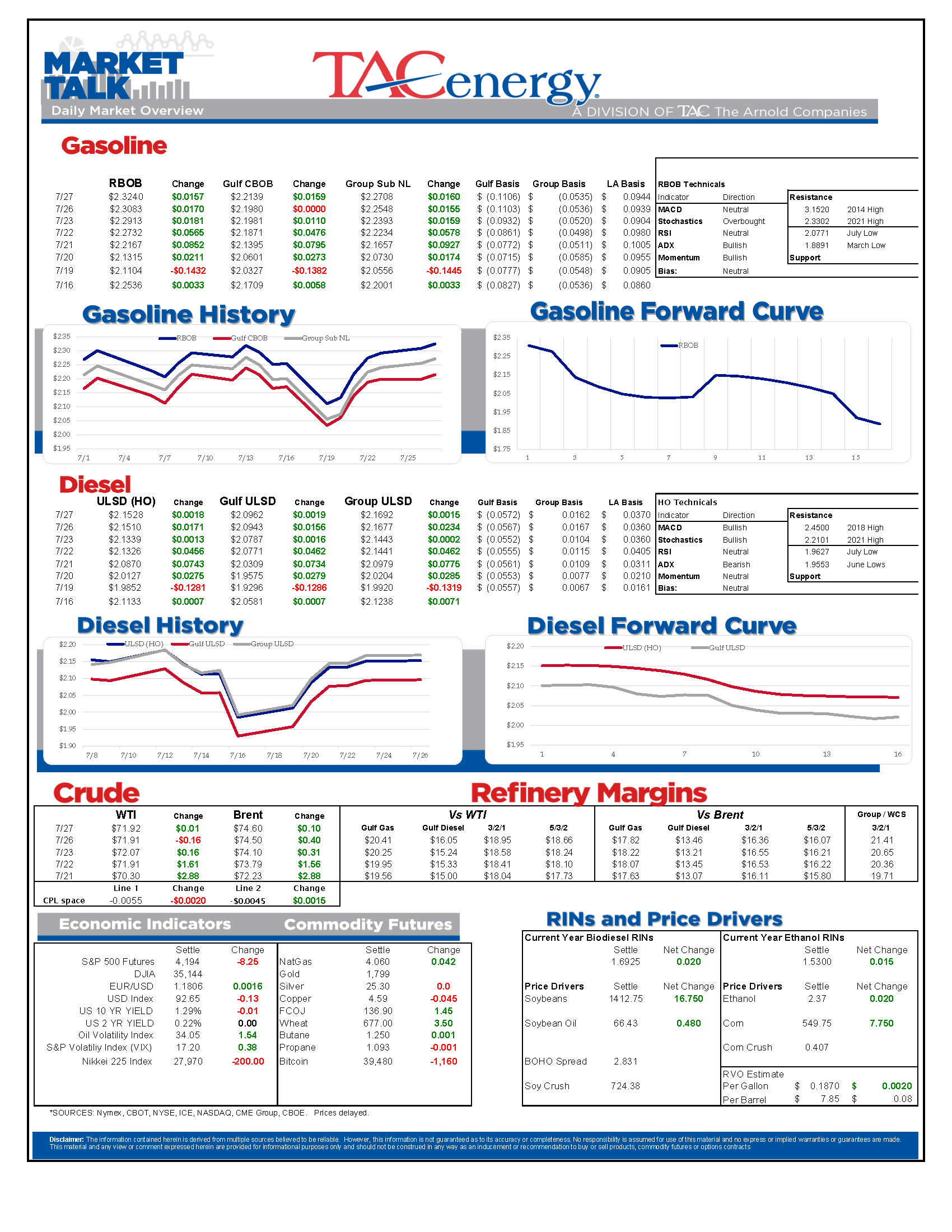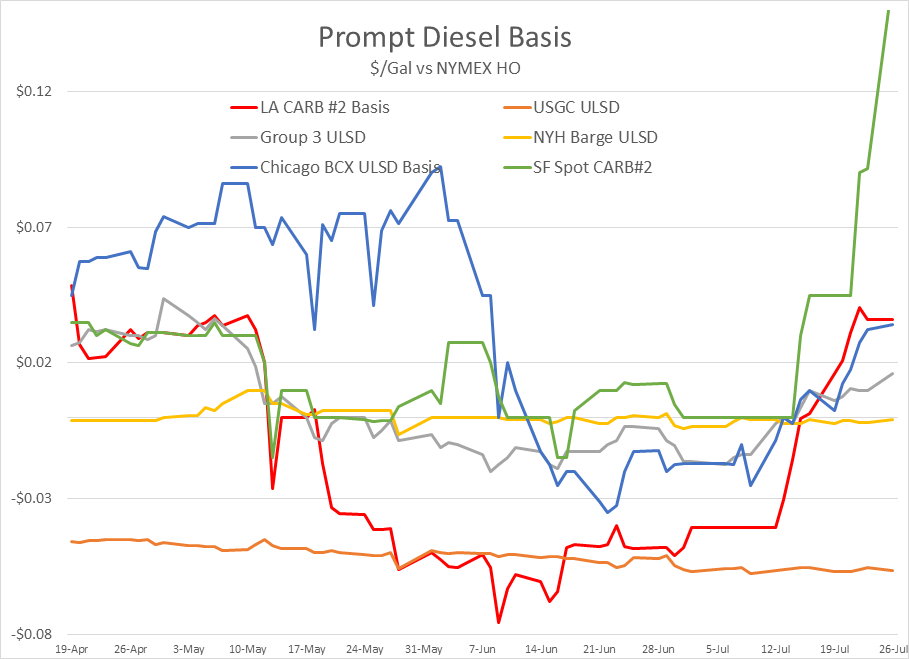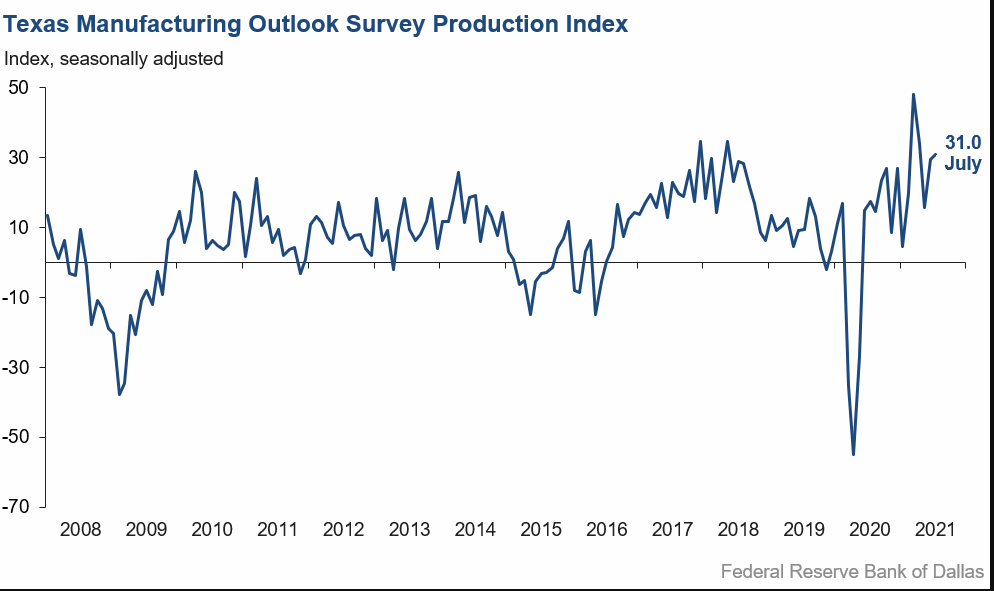RBOB Gasoline Futures Try To Lead Petroleum Complex

RBOB gasoline futures are trying to lead the rest of the petroleum complex on another rally this week, moving higher for a 6th straight sessions, and coming within $.0025/gallon of reaching a new 7 year high overnight. Diesel and crude oil contracts are reluctant to follow so far, and remain a few percentage points below the multi-year highs they set earlier in the month. Which contract wins the tug of war this week may well determine if the 8 month old rally can continue, or if we’ll see a more substantial pull back in prices this fall.
The Dallas Fed’s manufacturing survey for July showed another month of above average production for the state, while also highlighting the ongoing inflationary pressures many companies are facing. The report also offered a glimpse into the challenging labor market that is being felt across industries, and the country.
American Airlines is the latest in the long list of companies impacted by the driver shortage this summer, and has encouraged pilots to conserve fuel as a result. Make no mistake, it’s not a shortage of fuel - refiners would love to make more Jet – as that product does not create a Renewable Volume Obligation like gasoline and ULSD do, and is one of the last outlets for higher sulfur blends, it’s a lack of capacity to get that fuel where it needs to go.
While there may be plenty of fuel nationwide, regional shortages are becoming more common, with the San Francisco bay area becoming the latest to see prices spike as inventories dwindle. SF diesel basis values spiked another 7 cents in Monday’s trading, adding 16 cents to those differentials in the past 2 weeks. With two of the areas 5 refineries already shutting their doors to convert to renewable diesel production, and 2 more being told last week they’ll need to spend hundreds of millions of dollars to install equipment to reduce pollution, it seems like resupply will have to come from overseas.
LA Spot values have also risen due to a pair of refinery issues in July, but are so far lagging the move this week. In normal years, we’d expect a fleet of trucks to long haul fuel to alleviate the regional shortages across the Western half of the country, but, well, you know the story.
Today’s interesting read: The wave of deal making changing the landscape of US oil drillers.
Click here to download a PDF of today's TACenergy Market Talk.
News & Views
View All
Energy Futures Are Caught Up In Headline Tug-O-War This Morning
Energy futures are caught up in headline tug-o-war this morning with Canadian oil production concerns and a positive US GDP report trying to push prices higher while sinking Chinese demand worries and Gaza ceasefire hopes are applying downward pressure. The latter two seem to be favored more so far this morning with WTI and Brent crude oil futures down ~45 cents per barrel, while gasoline and diesel prices are down about half a cent and two cents, respectively.
No news is good news? Chicago gasoline prices dropped nearly 30 cents yesterday, despite there not being any update on Exxon’s Joliet refinery after further damage was discovered Wednesday. Its tough to say if traders have realized the supply situation isn’t as bad as originally thought or if this historically volatile market is just being itself (aka ‘Chicago being Chicago’).
The rain isn’t letting up along the Texas Gulf Coast today and is forecasted to carry on through the weekend. While much of the greater Houston area is under flood watch, only two refineries are within the (more serious) flood warning area: Marathon’s Galveston Bay and Valero’s Texas City refineries. However, notification that more work is needed at Phillip’s 66 Borger refinery (up in the panhandle) is the only filing we’ve seen come through the TECQ, so far.
Premiums over the tariff on Colonial’s Line 1 (aka linespace value) returned to zero yesterday, and actually traded in the negatives, after its extended run of positive values atypical of this time of year. Line 1’s counterpart, Line 2, which carries distillates from Houston to Greensboro NC, has traded at a discount so far this year, due to the healthy, if not over-, supply of diesel along the eastern seaboard.
Click here to download a PDF of today's TACenergy Market Talk.

WTI And Brent Crude Oil Futures Are Trading ~$1.50 Per Barrel Lower In Pre-Market Trading
The across-the-board drawdown in national energy stockpiles, as reported by the Department of Energy yesterday, stoked bullish sentiment Wednesday and prompt month gasoline, diesel, and crude oil futures published gains on the day. Those gains are being given back this morning.
The surprise rate cut by the People’s Bank of China is being blamed for the selling we are seeing in energy markets this morning. While the interest rate drop in both short- and medium-term loans won’t likely affect energy prices outright, the concern lies in the overall economic health of the world’s second largest economy and crude oil consumer. Prompt month WTI and Brent crude oil futures are trading ~$1.50 per barrel lower in pre-market trading, gasoline and diesel are following suit, shaving off .0400-.0450 per gallon.
Chicagoland RBOB has maintained its 60-cent premium over New York prices through this morning and shows no sign of coming down any time soon. Quite the opposite in fact: the storm damage, which knocked Exxon Mobil’s Joliet refinery offline on 7/15, seems to be more extensive than initially thought, potentially extending the repair time and pushing back the expected return date.
There are three main refineries that feed the Chicago market, the impact from one of them shutting down abruptly can be seen in the charts derived from aforementioned data published by the DOE. Refinery throughput in PADD 2 dropped 183,000 barrels per day, driving gasoline stockpiles in the area down to a new 5-year seasonal low.
While it seems all is quiet on the Atlantic front (for now), America’s Refineryland is forecasted to receive non-stop rain and thunderstorms for the next four days. While it may not be as dramatic as a hurricane, flooding and power outages can shut down refineries, and cities for that matter, all the same, as we learned from Beryl.




